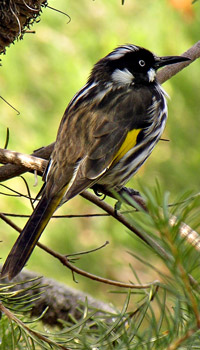Common Birds of the
Australian National Botanic Gardens
The Australian National Botanic Gardens provides a haven for many birds. The diversity of native plant species and the range of habitats provide food and shelter for a greater variety and larger numbers of birds than might otherwise be expected in Canberra.
A full list of birds in the Gardens is available from the Visitor Information Centre.
The bird calls below were originally transferred audially from tape to a Sun Sparcstation and stored in uncompressed 8-bit Sun audio format in 1993, then later converted to MP3 format in 2005.
 Australian
Wood Duck - Chenonetta jubata
Australian
Wood Duck - Chenonetta jubata
[colour illustration] [line drawing]
Australian Wood Ducks can be seen around the pools near the Cafe and grazing on grassed areas such as the Eucalypt Lawn. They breed regularly near the Cafe. The Wood Duck feeds almost entirely on vegetation, particularly grasses. The birds commonly associate in small flocks. They occur around water courses and lakes in eastern and south-western Australia. The range of the Wood Duck has expanded since European settlement as its habitat has increased through land clearing.
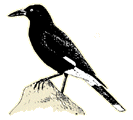 Pied Currawong - Strepera graculina
Pied Currawong - Strepera graculina
[ colour illustration ] [ line drawing ] [ bird call MP3]
Pied Currawongs can be seen (and heard!) throughout the Gardens and are common near the Cafe, where they scavenge scraps. They naturally occur in the forests and woodlands of eastern Australia and migrate from the highlands to lower altitudes in winter. Their diet includes fruits and grasses, insects and small vertebrates, even nestling birds.
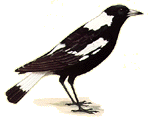 Australian
Magpie - Gymnorhina tibicen
Australian
Magpie - Gymnorhina tibicen
[ colour illustration ] [ line drawing ] [ bird call MP3] [group of birds calling MP3]
Magpies are common in most parts of the Gardens. They occur naturally throughout Australia, but are less common in the arid inland areas and along the northern coast. Magpies also occur in Papua New Guinea and have been introduced to New Zealand. During the breeding season in spring, male magpies protect their territory by 'swooping' intruders; a painful experience for those unlucky enough to be hit. The magpie forages on the ground for insects, worms and seeds.
 White-winged
Chough - Corcorax melanorhamphos
White-winged
Chough - Corcorax melanorhamphos
[ colour illustration ] [ line drawing ] [ bird call MP3]
Groups of White-winged Choughs can be seen scratching through the garden bed mulch in most areas of the Gardens. They are searching for insects and other invertebrates which form the bulk of their diet. They occur naturally in woodland and forest areas of south-eastern Australia. White-winged Choughs breed communally and construct mud nests. Sometimes more than one female lays eggs in the nest.
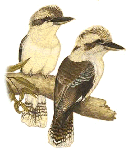 Laughing
Kookaburra - Dacelo novaeguineae
Laughing
Kookaburra - Dacelo novaeguineae
[ colour illustration ] [ line drawing ] [ bird call MP3]
The 'laugh' of the Kookaburra is one of the most enduring sounds of the Australian bush. In the Gardens Kookaburras are usually seen perched high in trees or on tall poles, watching for prey. Kookaburras feed on insects and worms, swooping down on small water animals such as frogs, reptiles and other small vertebrate animals. Before European settlement Kookaburras were found only in mainland eastern Australia, but they were introduced to Tasmania and Western Australia on several occasions between 1897 and 1912 and have now established there.
 Crimson Rosella - Platycercus elegans
Crimson Rosella - Platycercus elegans
[ colour illustration ] [ line drawing ] [ bird call MP3]
Crimson Rosellas, with startling crimson and blue plumage, are common in the Gardens. They are tree or ground foragers and can be seen eating the fruits of trees and shrubs or the spore capsules from the underside of tree ferns in the Rainforest Gully. The rosella beak is very efficient at tearing open fruits. Crimson Rosellas occur in a variety of forest habitats in south-eastern Australia and usually live in small flocks. Eastern Rosellas (Platycercus eximus) are also found in the Gardens, in more open woodland. They can be recognised by the splashes of yellow feathers and the lettuce green rump.
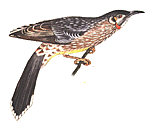 Red
Wattlebird - Anthochaera carunculata
Red
Wattlebird - Anthochaera carunculata
[ colour illustration ] [ line drawing ]
One of the most common (and raucous) birds in the Gardens is the Red Wattlebird. They are generally seen feeding on the nectar of the many banksias, waratahs and grevilleas. Red Wattlebirds (named because of the red lobes of skin, called 'wattles', at the side of the neck) also feed on insects and fruit. They occur naturally in native forests and woodlands of southern Australia and are common in parks and gardens.
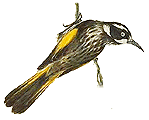 New Holland Honeyeater - Phylidonyris novaehollandiae
New Holland Honeyeater - Phylidonyris novaehollandiae
[ colour illustration ] [ line drawing ]
New Holland Honeyeaters are attracted to nectar-producing flowers, especially those such as banksias and grevilleas. The tongue of the birds has a 'brush' at the end, which helps gather the sweet nectar. The birds also eat insects. New Holland Honeyeaters occur naturally in forest, woodland and heath areas within a few hundred kilometres of the coast of southern Australia.
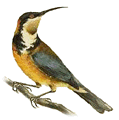 Eastern Spinebill - Acanthorhynchus tenuirostris
Eastern Spinebill - Acanthorhynchus tenuirostris
[ colour illustration ] [ line drawing ] [ bird call MP3]
Many of the plants growing in the Gardens bear flowers which produce large quantities of nectar. Birds attracted to feed from the flowers, such as the Eastern Spinebill, then carry pollen from flower to flower. Eastern Spinebills occur naturally in rainforest, woodland and heath areas of the eastern coast of Australia. They feed mostly on nectar but also catch insects, especially to feed to young.
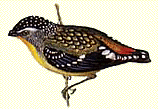 Spotted Pardalote - Pardalotus punctatus
Spotted Pardalote - Pardalotus punctatus
[ colour illustration ] [ line drawing ]
The tiny Spotted Pardalote can often be heard high in the tree tops feeding on insects which are picked from the leaves of eucalypts. It has a soft piping voice. They are most commonly seen during the winter months. The birds naturally occur in eastern and south-western Australia. They generally move in small groups, but may form larger flocks during the winter.
 White-browed
Scrubwren - Sericornis frontalis
White-browed
Scrubwren - Sericornis frontalis
[ colour illustration ] [ line drawing ]
White-browed Scrubwrens can be found in most shrub-covered areas of the Gardens and are very common in the Rainforest Gully. They are usually seen in pairs or small groups close to the ground. White-browed Scrubwrens occur naturally in dense undergrowth in the forests, woodlands and heathlands of eastern and south western Australia. They feed on a diet of insects and other small invertebrates.
 Superb Fairy-wren - Malurus cyaneus
Superb Fairy-wren - Malurus cyaneus
[ colour illustration ] [ line drawing ] [ bird call MP3 ] [ bird call long MP3 ]
Superb Fairy-wrens are a common sight among the shrubs and low-growing bushes of the Gardens. The wrens often live in groups of 6 to 12 birds and feed mainly on a diet of small insects found in low shrubbery and on the ground. They occur naturally in most areas of south-eastern Australia. Cats are a major predator. The male wren can be recognised by its blue feathers, which are especially prominent during the breeding season in spring.
[ Line drawings linked from the text are reproduced from Blakers, M. et al. The Atlas of Australian Birds. Melbourne University Press, 1984 with the kind permission of the Royal Australasian Ornithologists Union (now BirdLife Australia). ]
![Director of National Parks [logo]](../../../../../images/dnp_90px.gif)





